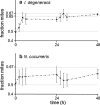Whether ideal free or not, predatory mites distribute so as to maximize reproduction
- PMID: 22081260
- PMCID: PMC3326238
- DOI: 10.1007/s00442-011-2190-y
Whether ideal free or not, predatory mites distribute so as to maximize reproduction
Abstract
Ideal free distribution (IFD) models predict that animals distribute themselves such that no individual can increase its fitness by moving to another patch. Many empirical tests assume that the interference among animals is independent of density and do not quantify the effects of density on fitness traits. Using two species of predatory mites, we measured oviposition as a function of conspecific density. Subsequently, we used these functions to calculate expected distributions on two connected patches. We performed an experimental test of the distributions of mites on two such connected patches, among which one had a food accessibility rate that was twice as high as on the other. For one of the two species, Iphiseius degenerans, the distribution matched the expected distribution. The distribution also coincided with the ratio of food accessibility. The other species, Neoseiulus cucumeris, distributed itself differently than expected. However, the oviposition rates of both species did not differ significantly from the expected oviposition rates based on experiments on single patches. This suggests that the oviposition rate of N. cucumeris was not negatively affected by the observed distribution, despite the fact that N. cucumeris did not match the predicted distributions. Thus, the distribution of one mite species, I. degenerans, was in agreement with IFD theory, whereas for the other mite species, N. cucumeris, unknown factors may have influenced the distribution of the mites. We conclude that density-dependent fitness traits provide essential information for explaining animal distributions.
Figures





References
-
- Abrahams MV. Patch choice under perceptual constraints—a cause for departures from an ideal free distribution. Behav Ecol Sociobiol. 1986;19:409–415. doi: 10.1007/BF00300543. - DOI
-
- Begon M, Harper JL, Townsend CR (1990) Ecology: individuals, populations and communities. Blackwell, Oxford
-
- De Moraes GJ, McMurtry JA et al (2004) A revised catalog of the mite family Phytoseiidae. Zootaxa 434:1–494
Publication types
MeSH terms
LinkOut - more resources
Full Text Sources

